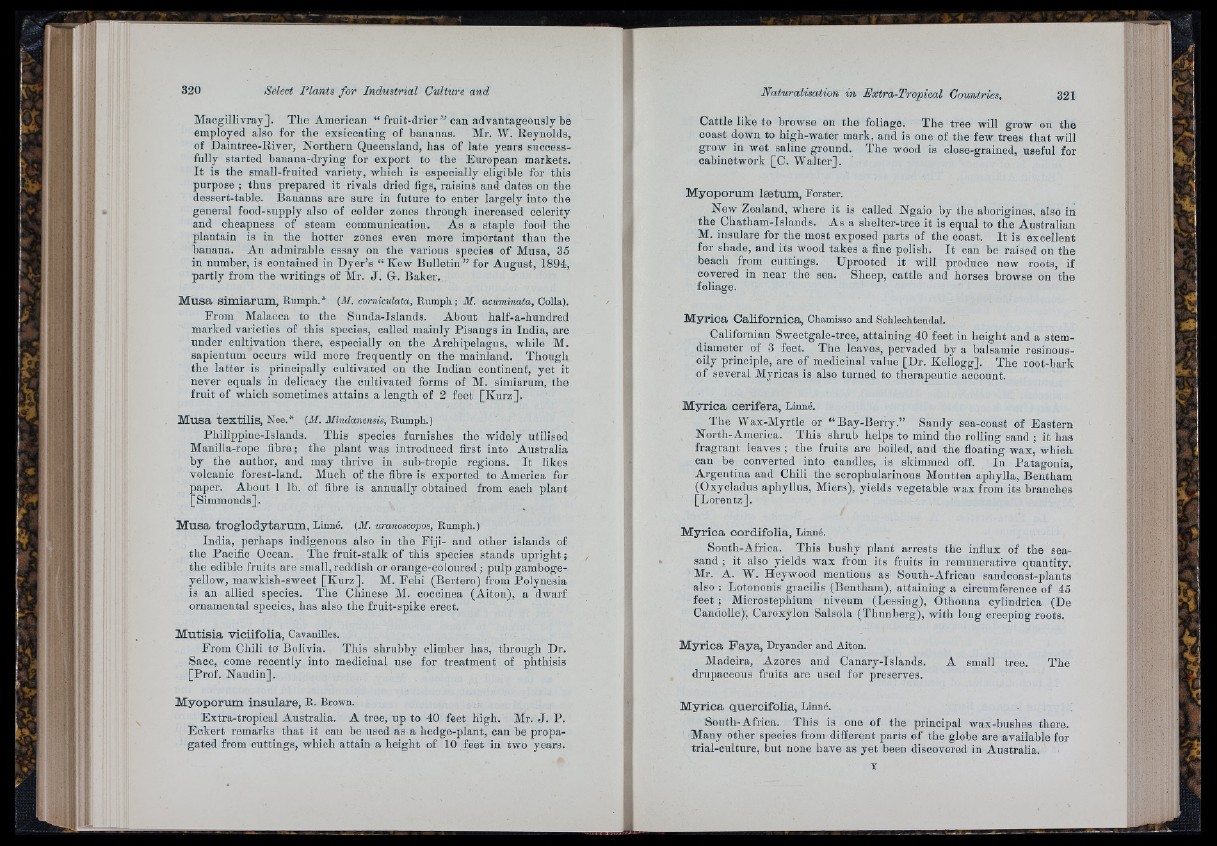
■'■'■i
íLÍ.
Macgillivray], The American “ fruit-drier ” can advantageously be
employed also for the exsiccating of bananas. Mr. W. Reynolds,
of Daintree-River, Northern Queensland, has of late years successfully
started banana-drying for export to the European markets.
I t is the small-fruited variety, which is especially eligible for this
purpose ; thus prepared it rivals dried figs, raisins and dates on the
dessert-table. Bananas are sure in future to enter largely into the
general food-supply also of colder zones through increased celerity
and cheapness of steam communication. As a staple food the
plantain is in the hotter zones even more important than the
banana. An admirable essay on the various species of Musa, 35
in number, is contained in Dyer’s “ Kew Bulletin” for August, 1894,
partly from the writings of Mr. J . G. Baker.
Musa simiarum, Rumph.* (M. corniculata, Rumph; M. acuminata, Colla).
From Malacca to the Sunda-Islands. Abont half-a-hundred
marked varieties of this species, called mainly Pisangs in India, are
under eultivation there, especially on the Archipelagus, while M.
sapientum occurs wild more frequently on the mainland. Though
the latter is principally cultivated on the Indian continent, yet it
never equals in delicacy the cultivated forms of M. simiarum, the
fruit of which sometimes attains a length of 2 feet [Kurz],
Musa textiRs, Nee.* {M. Mindanensis, Rumph.)
Philippine-Islands. This species furnishes the widely utilised
Manilla-rope fibre ; the plant was introduced first into Australia
by the author, and may thrive in snb-tropio regions. I t likes
volcanic forest-land. Much of the fibre is exported to America for
laper. About 1 lb. of fibre is annually obtained from each plant
[Simmonds].
Musa troglodytarum, Linné. (M. uranoscopos, Rumph.)
India, perhaps indigenous also iu the Fiji- and other islands of
the Pacific Ocean. The fruit-stalk of this species stands upright ;
the edible fruits are small, reddish or orange-coloured ; pulp gamboge-
yellow, mawkish-sweet [Kurz], M. Eehi (Bertero) from Polynesia
is an allied species. The Chinese M. coccínea (Aiton), a dwarf
ornamental species, has also the fruit-spike erect.
Mutisia viciifolia, Cavanilles.
From Chili to Bolivia. This shrubby climber has, through Dr.
Sacc, come recently into medicinal use for treatment of phthisis
[Prof. Naudin].
Myoporum insulare, R. Brown.
Extra-tropical Australia. A tree, up to 40 feet high. Mr. J . P.
Eckert remarks th a t it can be used as a hedge-plant, can be propagated
from cuttings, which attain a height of 10 feet in two years.
Cattle like to browse on the foliage. The tree will grow on the
coast down to high-water mark, and is one of the few treqs th a t will
grow in wet saline ground. The wood is close-grained, useful for
cabinetwork [C. Walter].
Myoporum lætum, Forster.
New Zealand, where it is called Ngaio by the aborigines, also in
the Chatham-Islands. As a shelter-tree it is equal to the Australian
M. insulare for the most exposed parts of the coast. I t is excellent
for shade, and its wood takes a fine polish. I t can be raised on the
beach from cuttings. Uprooted it will produce new roots, if
covered in near the sea. Sheep, cattle and horses browse on the
foliage.
Myrica Californica, Chamisso and Schlechtendal.
Californian Sweetgale-tree, attaining 40 feet in height and a stem-
diameter of 3 feet. The leaves, pervaded by a balsamic resinous-
oily principle, are of medicinal value [Dr. Kellogg]. The root-bark
of several Myricas is also turned to therapeutic account.
Myrica oerifera, Linné.
The Wax-Myrtle or “ Bay-Berry.” Sandy sea-coast of Eastern
North-America. This shrub helps to mind the rolling sand ; it has
fragrant leaves ; the fruits are boiled, and the floating wax, which
can be converted into candles, is skimmed off. In Patagonia,
Argentina and Chili the scrophularinous Mouttea aphylla, Bentham
(Cxycladus aphyllus, Miers), yields vegetable wax from its branches
[Lorentz].
Myrica cordifolia, Linné.
South-Africa. This bushy plant arrests the influx of the sea-
sand ; it also yields wax from its fruits in remunerative quantity.
Mr. A. W. Heywood mentions as South-African sandcoast-plants
also : Lotononis gracilis (Bentham), attaining a circumference of 45
feet ; Microstephium niveum (Lessing), Cthonna cylindrica (De
Candolle), Caroxylon Salsola (Thunberg), with long creeping roots.
Myrica Faya, Dryander and Aiton.
Madeira, Azores aud Canary-Islands.
drupaceous fruits are used for pz-eserves.
A small tree. The
Myrica quercifolia, Linné.
South-Africa. This is one of the principal wax-bushes there.
Many other species from different parts of the globe are available for
trial-culture, but none have as yet been discovered in Australia.